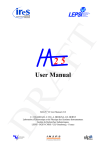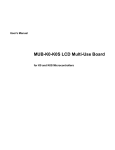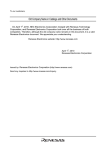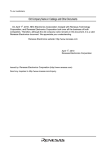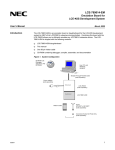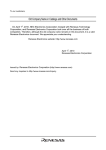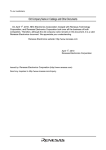Download Old Company Name in Catalogs and Other Documents
Transcript
To our customers, Old Company Name in Catalogs and Other Documents On April 1st, 2010, NEC Electronics Corporation merged with Renesas Technology Corporation, and Renesas Electronics Corporation took over all the business of both companies. Therefore, although the old company name remains in this document, it is a valid Renesas Electronics document. We appreciate your understanding. Renesas Electronics website: http://www.renesas.com April 1st, 2010 Renesas Electronics Corporation Issued by: Renesas Electronics Corporation (http://www.renesas.com) Send any inquiries to http://www.renesas.com/inquiry. Notice 1. 2. 3. 4. 5. 6. 7. All information included in this document is current as of the date this document is issued. Such information, however, is subject to change without any prior notice. Before purchasing or using any Renesas Electronics products listed herein, please confirm the latest product information with a Renesas Electronics sales office. Also, please pay regular and careful attention to additional and different information to be disclosed by Renesas Electronics such as that disclosed through our website. Renesas Electronics does not assume any liability for infringement of patents, copyrights, or other intellectual property rights of third parties by or arising from the use of Renesas Electronics products or technical information described in this document. No license, express, implied or otherwise, is granted hereby under any patents, copyrights or other intellectual property rights of Renesas Electronics or others. You should not alter, modify, copy, or otherwise misappropriate any Renesas Electronics product, whether in whole or in part. Descriptions of circuits, software and other related information in this document are provided only to illustrate the operation of semiconductor products and application examples. You are fully responsible for the incorporation of these circuits, software, and information in the design of your equipment. Renesas Electronics assumes no responsibility for any losses incurred by you or third parties arising from the use of these circuits, software, or information. When exporting the products or technology described in this document, you should comply with the applicable export control laws and regulations and follow the procedures required by such laws and regulations. You should not use Renesas Electronics products or the technology described in this document for any purpose relating to military applications or use by the military, including but not limited to the development of weapons of mass destruction. Renesas Electronics products and technology may not be used for or incorporated into any products or systems whose manufacture, use, or sale is prohibited under any applicable domestic or foreign laws or regulations. Renesas Electronics has used reasonable care in preparing the information included in this document, but Renesas Electronics does not warrant that such information is error free. Renesas Electronics assumes no liability whatsoever for any damages incurred by you resulting from errors in or omissions from the information included herein. Renesas Electronics products are classified according to the following three quality grades: “Standard”, “High Quality”, and “Specific”. The recommended applications for each Renesas Electronics product depends on the product’s quality grade, as indicated below. You must check the quality grade of each Renesas Electronics product before using it in a particular application. You may not use any Renesas Electronics product for any application categorized as “Specific” without the prior written consent of Renesas Electronics. Further, you may not use any Renesas Electronics product for any application for which it is not intended without the prior written consent of Renesas Electronics. Renesas Electronics shall not be in any way liable for any damages or losses incurred by you or third parties arising from the use of any Renesas Electronics product for an application categorized as “Specific” or for which the product is not intended where you have failed to obtain the prior written consent of Renesas Electronics. The quality grade of each Renesas Electronics product is “Standard” unless otherwise expressly specified in a Renesas Electronics data sheets or data books, etc. “Standard”: 8. 9. 10. 11. 12. Computers; office equipment; communications equipment; test and measurement equipment; audio and visual equipment; home electronic appliances; machine tools; personal electronic equipment; and industrial robots. “High Quality”: Transportation equipment (automobiles, trains, ships, etc.); traffic control systems; anti-disaster systems; anticrime systems; safety equipment; and medical equipment not specifically designed for life support. “Specific”: Aircraft; aerospace equipment; submersible repeaters; nuclear reactor control systems; medical equipment or systems for life support (e.g. artificial life support devices or systems), surgical implantations, or healthcare intervention (e.g. excision, etc.), and any other applications or purposes that pose a direct threat to human life. You should use the Renesas Electronics products described in this document within the range specified by Renesas Electronics, especially with respect to the maximum rating, operating supply voltage range, movement power voltage range, heat radiation characteristics, installation and other product characteristics. Renesas Electronics shall have no liability for malfunctions or damages arising out of the use of Renesas Electronics products beyond such specified ranges. Although Renesas Electronics endeavors to improve the quality and reliability of its products, semiconductor products have specific characteristics such as the occurrence of failure at a certain rate and malfunctions under certain use conditions. Further, Renesas Electronics products are not subject to radiation resistance design. Please be sure to implement safety measures to guard them against the possibility of physical injury, and injury or damage caused by fire in the event of the failure of a Renesas Electronics product, such as safety design for hardware and software including but not limited to redundancy, fire control and malfunction prevention, appropriate treatment for aging degradation or any other appropriate measures. Because the evaluation of microcomputer software alone is very difficult, please evaluate the safety of the final products or system manufactured by you. Please contact a Renesas Electronics sales office for details as to environmental matters such as the environmental compatibility of each Renesas Electronics product. Please use Renesas Electronics products in compliance with all applicable laws and regulations that regulate the inclusion or use of controlled substances, including without limitation, the EU RoHS Directive. Renesas Electronics assumes no liability for damages or losses occurring as a result of your noncompliance with applicable laws and regulations. This document may not be reproduced or duplicated, in any form, in whole or in part, without prior written consent of Renesas Electronics. Please contact a Renesas Electronics sales office if you have any questions regarding the information contained in this document or Renesas Electronics products, or if you have any other inquiries. (Note 1) “Renesas Electronics” as used in this document means Renesas Electronics Corporation and also includes its majorityowned subsidiaries. (Note 2) “Renesas Electronics product(s)” means any product developed or manufactured by or for Renesas Electronics. LCE-789418-EM Emulation Board for LCE-K0S Development System User’s Manual Introduction March 2000 The LCE-789418-EM is an emulation board or daughterboard for the LCE-K0S development system for NEC’s 8-bit µPD789418 subseries microcontrollers. Combining this board with the LCE-78K0S allows you to efficiently emulate any µPD789418 subseries device. The LCE789418-EM is shipped with the following contents: ! LCE-789418-EM daughterboard ! User’s manual ! Two 50-pin ribbon cables ! CD-ROM containing debugger, compiler, assembler, and documentation Figure 1. System Configuration Debugger ID78K0S-LCE and DF78K0S Device File Host PC with Windows 95/98/NT Straight-Through Parallel Cabl (sold separately) Power Adapter (sold separately) Motherboard Daughterboard Two Ribbon Cables LCE-78K0S (sold separately) LCE-789418-EM Prob NP-80GC or NP-80GK (sold separately) Conversion Socket for Probe Onl (sold separately) Two Methods of Connecting the LCE-K0S to the User Targe Document No. U18144EU1V0UM00 (1st edition) 50900 1 LCE-789418-EM Emulation Board Table 1. Basic Specifications Parameter Description Target device µPD789405 µPD789406 µPD789407 µPD789415 µPD789416 µPD789417 µPD789418 Clock supply Internal: installed on the motherboard External: pulse input Low-voltage compatible Components The LCE-789418-EM daughterboard mates with the LCE-78K0S motherboard. In other words, the top of the daughterboard faces down in the system. As shown in Figure 2, a top view of the daughterboard, U1 is the Realchip that provides peripherals unique to the µPD789418 devices. U3 is the user-defined LCD division resistor ladders. Figure 2. Top View of Daughterboard 2 At least 2 volts LCE-789418-EM Emulation Board In the bottom view shown in Figure 3, J1, P1, and P2 are connectors to the user target. These connectors contain all of the pins available on the device. J1 is a KEL connector for the probe, while P1 and P2 are dual-row, male-shrouded headers with latching levers for the ribbon cables. See Tables 2-4 for pin assignments. S1 is a DIP switch for enabling or disabling pull-up resistors on the input pins for mask ROM. P3 and P4 are connectors for the motherboard, which attaches to the top of the daughterboard. Figure 3. Bottom View of Daughterboard 3 LCE-789418-EM Emulation Board Ribbon Cable The ribbon cable is a 50-pin female-to-female cable that connects the LCE-K0S to the user target. Alternatively, an emulation probe may be used. One end of the ribbon cable connects to the daughterboard and the other to the target. Since all devices in this product group are 80pin devices, two ribbon cables are shipped with the daughterboard. The side of the ribbon cable with a red stripe is pin 1. Table 2. P1 Pin Assignment P1 Connector 4 µPD7894xx Device Pin Signal Note 1 GND on probe cable 2 GND on probe cable 3 GND on probe cable 4 GND on probe cable 5 1 VDD1 6 2 BIAS 7 3 VLC0 8 4 VLC1 9 5 VLC2 10 6 VSS1 11 7 COM0 12 8 COM1 13 9 COM2 14 10 COM3 15 11 S0 16 12 S1 17 13 S2 18 14 S3 19 15 S4 20 16 S5 21 17 S6 22 18 S7 23 19 S8 24 20 S9 25 21 S10 26 22 S11 27 23 S12 28 24 S13 29 25 S14 30 26 S15 31 27 P93/S16 32 28 P92/S17 33 29 P91/S18 34 30 P90/S19 35 31 P87/S20 36 32 P86/S21 37 33 P85/S22 PB_VDD is voltage sense; tied to pin 71, VDD0 VSS1 is tied to GN LCE-789418-EM Emulation Board Table 2. P1 Pin Assignments (continued) P1 Connector µPD7894xx Device Pin Signal 38 34 P84/S23 39 35 P83/S24 40 36 P82/S25 41 37 P81/S26 42 38 P80/S27 Note 43 GND on probe cable 44 GND on probe cable 45 GND on probe cable 46 GND on probe cable 47 GND on probe cable 48 GND on probe cable 49 GND on probe cable 50 GND on probe cable Table 3. P2 Pin Assignments P2 Connector µPD7894xx Device Pin Signal Note 1 GND on probe cable 2 GND on probe cable 3 GND on probe cable 4 GND on probe cable 5 39 AVDD 6 40 AVREF 7 41 P66/ANI6 8 42 P65/ANI5 9 43 P64/ANI4 10 44 P63/ANI3 11 45 P62/ANI2 12 46 P61/ANI1/ CMPREF0 13 47 P60/ANI0/ CMPIN0 14 48 AVSS 15 49 P27/INTP3/CPT5 16 50 P26/INTP2/TO5 17 51 P25/INTP1/TI1 18 52 P24/INTP0/TI0 19 53 P23/CMPTOUT0/ TO2 20 54 P22/SI/RXD 21 55 P21/SO/TXD 22 56 P20/SCK/ASCK 23 57 P53 AVSS is tied to GN 5 LCE-789418-EM Emulation Board Table 3. P2 Pin Assignments (continued) 6 P2 Connector µPD7894xx Device Pin Signal 24 58 P52 25 59 P51 26 60 P50 27 61 P03 28 62 P02 29 63 P01 30 64 P00 31 65 P47 32 66 P46 Note 33 67 RESET Negative true 34 68 X2 Not connected in LCE-789418-E 35 69 X1 External clock input for oscillator on target 36 70 VSS0 Tied to GND 37 71 VDD0 PB_VDD is used for voltage sense; tied to pin 1, VDD1 38 72 XT2 Not connected in LCE-789418-E 39 73 XT1 External subclock input for oscillator on target Not connected in LCE-789418-E 40 74 TEST/VPP 41 75 P45/KR 42 76 P44/KR 43 77 P43/KR 44 78 P42/KR 45 79 P41/KR 46 80 P40/KR 47 GND on probe cable 48 GND on probe cable 49 GND on probe cable 50 GND on probe cable LCE-789418-EM Emulation Board Emulation Probe (Optional) In place of ribbon cables, an emulation probe can be used to connect the LCE to the user target, provided the target has a conversion socket/adapter installed. Table 4. Emulation Probe Pin Assignments Emulation Device Pin No. J1 Pin No. Emulation Device Pin No. J1 Pin No. 1 114 41 8 2 113 42 7 3 108 43 14 4 107 44 13 5 104 45 18 6 103 46 17 7 100 47 22 8 99 48 21 9 94 49 28 10 93 50 27 11 30 51 92 12 29 52 91 13 24 53 98 14 23 54 97 15 20 55 102 16 19 56 101 17 16 57 106 18 15 58 105 19 10 59 112 20 9 60 111 21 37 61 83 22 43 62 77 23 44 63 78 24 47 64 73 25 48 65 74 26 51 66 69 27 52 67 70 28 57 68 63 29 58 69 64 30 59 70 61 31 60 71 62 32 55 72 65 33 56 73 66 34 49 74 71 35 50 75 72 36 45 76 75 37 46 77 76 38 41 78 79 39 42 79 80 40 35 80 85 7 LCE-789418-EM Emulation Board Table 5. Emulation Probe and Socket for µPD789418 Subseries Target Device Emulation Probe + Conversion Socket µPD789405GC NP-80GC or NP-80GC-TQ + EV-TGC-080SBP µPD789406GC µPD789407GC µPD789415GC µPD789416GC µPD789417GC µPD78F9418GC µPD789405GK NP-80GK + EV-TGK-080SDW µPD789406GK µPD789407GK µPD789415GK µPD789416GK µPD789417GK µPD78F9418GK Assembly This procedure explains how to connect the LCE-789418-EM to the LCE-78K0S motherboard. 1. Connect the probe or ribbon cables to their respective connectors on the LCE-789418-EM (Figure 4). Figure 4. Connections for Emulation Probe or Ribbon Cables Ribbon Cables OR Emulation Probe (sold separately) 2. 8 Make sure power is off from the LCE-78K0S motherboard. LCE-789418-EM Emulation Board 3. Remove the two screws at the bottom of the standoffs on the motherboard (Figure 5). Figure 5. Screws on Bottom of Motherboard • 4. With the daughterboard on a stable surface, connect the motherboard on the daughterboard by gently applying pressure on the mating connectors. Avoid applying too much pressure on the plastic cover (Figure 6). Figure 6. Daughterboard Mating Connectors A pply P res s ure o n th e M othe rbo a rd 9 LCE-789418-EM Emulation Board 5. Replace the screws on the bottom of the daughterboard to securely connect it to the motherboard (Figure 7). Figure 7. Connection to Motherboard 6. Connect the loose end of the probe or ribbon cables to the user target. Refer to Tables 2-4 for pin assignments. 7. With a 25-pin male-to-male parallel cable (not included), connect the LCE-K0S system to the host computer (Figure 8). Figure 8. Connection to Host PC Rear Side of the Motherboar Host PC Printer Port Straight-Through Parallel Cable 10 8. With the power adapter connected, turn the switch to the ON position. The green LED turns on when power is supplied to the system. 9. Launch the debugger from your PC. LCE-789418-EM Emulation Board 11 For literature, call 1-800-366-9782 7 a.m. to 6 p.m. Pacific time or FAX your request to 1-800-729-9288 or visit our web site at www.necel.com In North America: No part of this document may be copied or reproduced in any form or by any means without the prior written consent of NEC Electronics Inc. (NECEL). The information in this document is subject to change without notice. All devices sold by NECEL are covered by the provisions appearing in NECEL Terms and Conditions of Sales only. Including the limitation of liability, warranty, and patent provisions. NECEL makes no warranty, express, statutory, implied or by description, regarding information set forth herein or regarding the freedom of the described devices from patent infringement. NECEL assumes no responsibility for any errors that may appear in this document. NECEL makes no commitments to update or to keep current information contained in this document. The devices listed in this document are not suitable for use in applications such as, but not limited to, aircraft control systems, aerospace equipment, submarine cables, nuclear reactor control systems, and life support systems. “Standard” quality grade devices are recommended for computers, office equipment, communication equipment, test and measurement equipment, machine tools, industrial robots, audio and visual equipment, and other consumer products. For automotive and transportation equipment, traffic control systems, anti-disaster and anti-crime systems, it is recommended that the customer contact the responsible NECEL salesperson to determine the reliability requirements for any such application and any cost adder. NECEL does not recommend or approve use of any of its products in life support devices or systems or in any application where failure could result in injury or death. If customers wish to use NECEL devices in applications not intended by NECEL, customer must contact the responsible NECEL salespeople to determine NECEL's willingness to support a given application. ©2000 NEC Electronics Inc./Printed in U.S.A. 50900














